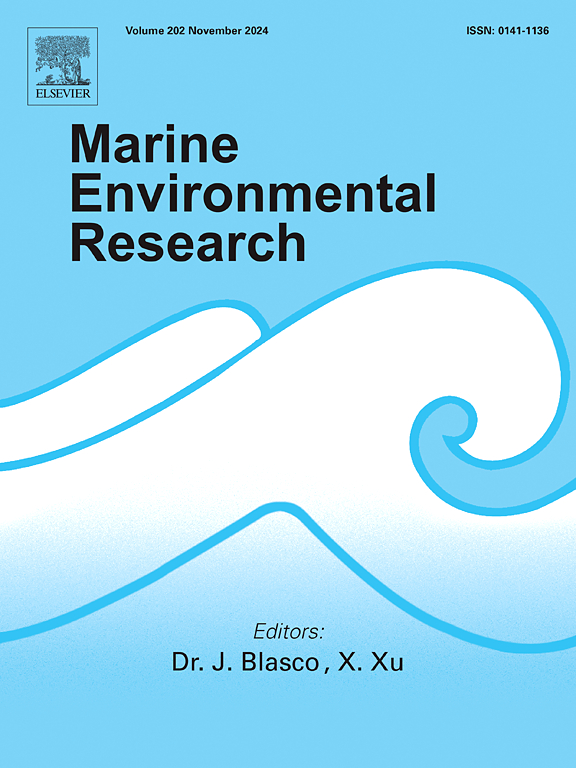入侵蓝与局部绿:两种蟹种——糙鳞蟹和闸蟹对基质的偏好分析
IF 3.2
3区 环境科学与生态学
Q2 ENVIRONMENTAL SCIENCES
引用次数: 0
摘要
主要通过压载水引入的大西洋蓝蟹,Callinectes sapidus,已经扩散到整个地中海,表现出高度入侵的行为。在引进的生态系统中,它对当地物种和经济活动构成威胁。本研究首次比较了C. sapidus和本地绿蟹——地中海岸蟹(Mediterranean Shore crab Carcinus aestuarii)在威尼斯泻湖的生境偏好。在受控的实验室条件下,利用天然沙质底部以及天然盐沼和人工盐沼的沉积物样本来评估两种物种对基质的偏好(在每种基质上花费的时间)。沉积物组成通过粒度分析来表征,以评估样品沉积物结构的差异。行为观察表明,石竹对天然底和人工盐沼中粒径较大的底物均有偏好,而石竹对底物无特定偏好。此外,sapidus还表现出更高的挖洞活动,这可能是由于其对沙质环境的适应和作为躲避捕食者策略的挖洞行为。人类驱动的侵蚀和恢复活动导致的水文形态变化正在增加威尼斯泻湖沉积物的沙质成分。因此,蓝蟹可能会在更广阔的地区茁壮成长。我们的研究结果对保护和管理具有重要意义,因为sapidus的扩张可能会通过竞争和捕食进一步威胁aestuarii种群,加剧当地手工渔业的衰退。本文章由计算机程序翻译,如有差异,请以英文原文为准。
Invasive blue vs. local Green: analysis of substrate preference of two crab species, Callinectes sapidus and Carcinus aestuarii
Introduced primarily via ballast waters, the Atlantic Blue Crab, Callinectes sapidus, has spread throughout the Mediterranean Sea exhibiting a highly invasive behaviour. In introduced ecosystems it is posing a threat to local species and economic activities. This study compares, for the first time, habitat preference of C. sapidus and the native green crab, the Mediterranean Shore Crab Carcinus aestuarii, in the Venice Lagoon. Sediment samples from natural sandy bottoms, as well as from natural and artificial saltmarshes were used to assess substrate preference (time spent on each substrate) of both species under controlled laboratory conditions. Sediment composition was characterized by granulometric analysis, to assess differences in the sediment structure of the samples. Behavioural observations indicated that C. sapidus exhibits a preference for substrates with larger grain size, that characterized both natural bottoms and artificial saltmarshes, whereas C. aestuarii showed no specific substrate preference. Moreover, C. sapidus demonstrated significantly higher burrowing activity, likely due to its adaptation to sandy environments and burrowing behaviour as a predation avoidance strategy. Hydro-morphological alterations driven by both human-driven erosion and by restoration actions are increasing the sandy component of the Venice lagoon sediments across habitats. As a result, the blue crab may potentially thrive in wider areas. Our findings have implications for conservation and management, as the expansion of C. sapidus could further threaten C. aestuarii populations through competition and predation, exacerbating the decline of local artisanal fisheries.
求助全文
通过发布文献求助,成功后即可免费获取论文全文。
去求助
来源期刊

Marine environmental research
环境科学-毒理学
CiteScore
5.90
自引率
3.00%
发文量
217
审稿时长
46 days
期刊介绍:
Marine Environmental Research publishes original research papers on chemical, physical, and biological interactions in the oceans and coastal waters. The journal serves as a forum for new information on biology, chemistry, and toxicology and syntheses that advance understanding of marine environmental processes.
Submission of multidisciplinary studies is encouraged. Studies that utilize experimental approaches to clarify the roles of anthropogenic and natural causes of changes in marine ecosystems are especially welcome, as are those studies that represent new developments of a theoretical or conceptual aspect of marine science. All papers published in this journal are reviewed by qualified peers prior to acceptance and publication. Examples of topics considered to be appropriate for the journal include, but are not limited to, the following:
– The extent, persistence, and consequences of change and the recovery from such change in natural marine systems
– The biochemical, physiological, and ecological consequences of contaminants to marine organisms and ecosystems
– The biogeochemistry of naturally occurring and anthropogenic substances
– Models that describe and predict the above processes
– Monitoring studies, to the extent that their results provide new information on functional processes
– Methodological papers describing improved quantitative techniques for the marine sciences.
 求助内容:
求助内容: 应助结果提醒方式:
应助结果提醒方式:


